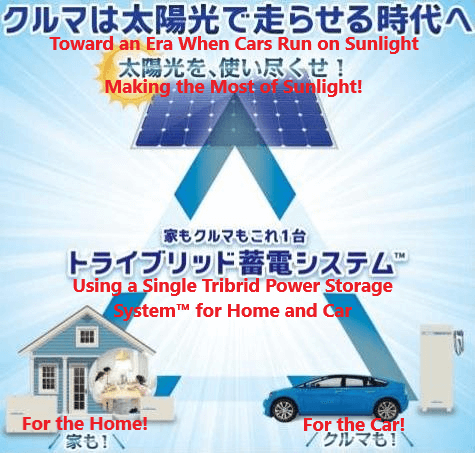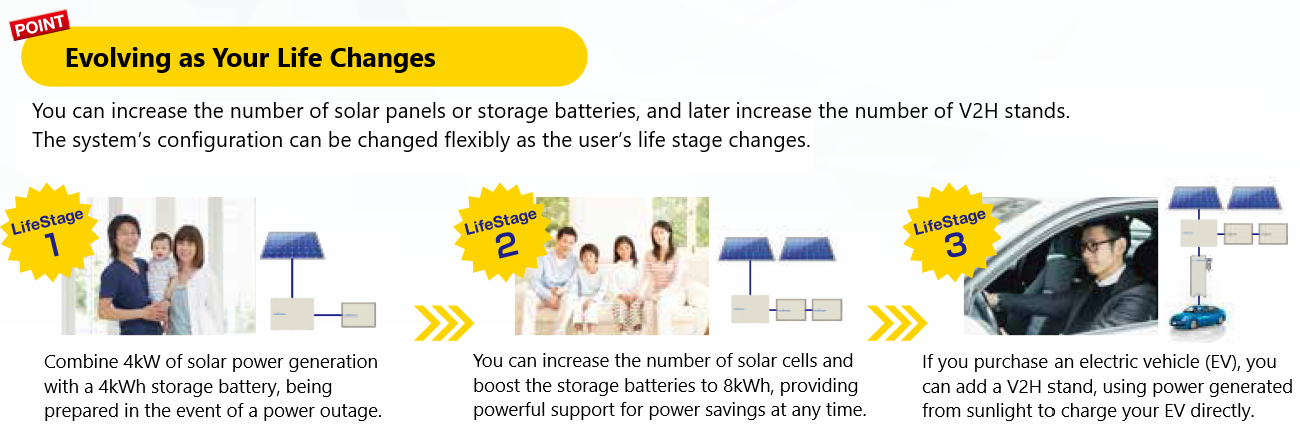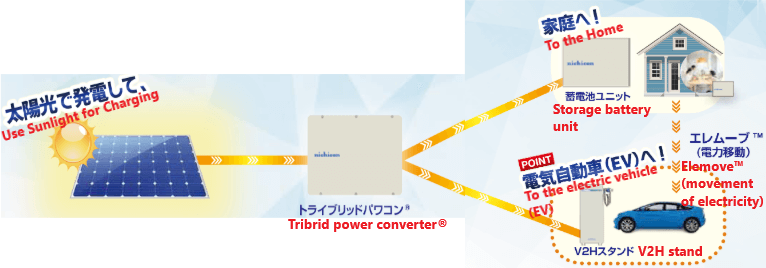NICHICON Develops the Tribrid Electricity Storage System, a Next-Generation Energy System that Connects Solar Cells, EVs/PHVs and Storage Batteries Toward a Time When Vehicles Will Run on Sunlight
Author: Nichicon
9/25/2017
In 2012, NICHICON CORPORATION took the industry lead in the development and market launch of a household energy storage system. Since that time, NICHICON has been the leading company in this category, with cumulative sales of around 40,000 units (as of September 2017). Meanwhile, to encourage the proliferation of electric vehicles (EVs), since 2009 we have supplied onboard power chargers for the Mitsubishi Motors i-MiEV—the first mass-produced EV—and in 2012 we developed and launched the world’s first V2H system, enabling connections between EVs and homes.
Based on the Company’s accumulated technologies and track record related to power storage systems and EVs and plug-in hybrid vehicles (PHVs), NICHICON has developed an altogether new next-generation energy storage system for connecting solar cells with EV/PHV batteries and storage batteries, the “tribrid electricity storage system.”
A product demonstrating the development concept of this system will be on display at CEATEC JAPAN 2017, taking place at Makuhari Messe from Tuesday to Thursday, October 3 to 6.
Development Background
The full-fledged proliferation of EVs is anticipated, in an effort to prevent global warming. However, ensuring the electric power needed to charge EVs presents an obstacle to EV proliferation. At the same time, by the time the feed-in tariff system concludes in fiscal 2019, some 580,000 homes are expected to be equipped with solar power generation equipment. At this point, it is forecast that the owners of these homes will shift from selling solar power to using this electricity for charging.
By enabling large-capacity electricity storage, the tribrid electricity storage system aims to encourage energy self-sufficiency and contribute to a low-carbon era by enabling EVs to run on electricity generated from sunlight. At the same time, the Company will contribute to the optimization of energy supply and demand through network controls, such as through virtual power plants (VPPs).
About Tribrid Electricity Storage Systems
The next-generation energy system NICHICON has developed—the tribrid electricity storage system—efficiently connects solar cells, EV/PHV batteries and storage batteries, creating a total energy system that can be used in a variety of scenarios. The electricity generated by solar cells can not only be used in the home or stored, but it can also be used to run EVs. A highly efficient system that provides a DC link to three batteries enables the movement of electricity (Elemove*1) between storage batteries and EV batteries. As a result, when an EV is not present, the power from solar cells can be stored in storage batteries. When the EV returns, the stored power can be transferred from the storage batteries to the EV, enabling carbon-free vehicle operation. In addition, in the event of a power outage, the storage battery and the EV’s large-capacity battery can be used as backup, providing even greater peace of mind. This system enables an extremely high level of self-sufficiency based on solar power generation for both homes and vehicles. As a result, we expect the system to encourage the proliferation of EVs and make a major contribution to improving the global environment.
Features
- The electricity generated from sunlight is stored in EV batteries and storage batteries, enabling household power consumption. In addition to being used in the home, the solar power generation can be used to run EVs, resulting in a total energy system.
- A highly efficient DC connection between three batteries—solar cells, EV batteries and storage batteries—minimizes the conversion loss, facilitating the movement of electricity (Elemove) between storage batteries.
- Consolidating three power converters—for solar cells, storage batteries and vehicle-to-home (V2H) systems—into one saves space.
- We expect to respond to new certification*2 facilitating the free combination and increase of solar cells, storage batteries and V2H systems at a later date.
- As users’ life stages change, they can upgrade the system by adding solar cells, adding storage batteries or increasing V2H stand connections.
- In the event of a power outage, storage batteries and EVs can instantaneously supply power to homes, contributing significantly to peace of mind. Power generated by mid-day sunlight can be stored for use at night, providing peace of mind, and power from storage batteries can be used to charge EVs.
- We expect the system to facilitate the offering of new services, by enabling control of a variety of travel modes with a single remote control, facilitating protection even without an HEMS (Home Energy Management System), facilitating the control of PV power output, complying with fiscal 2017 VPP restrictions, and allowing network app downloads.
*1: The transmission of power from storage batteries to EVs
*2: The Japan Electrical Safety & Environment Technology Laboratories’ “individual testing method for equipment to ensure grid connections for multi-input systems”

The Tribrid Electricity Storage System Concept

Overall Structure of the Tribrid Electricity Storage System

System Expansion

Expected sale date: April 2018